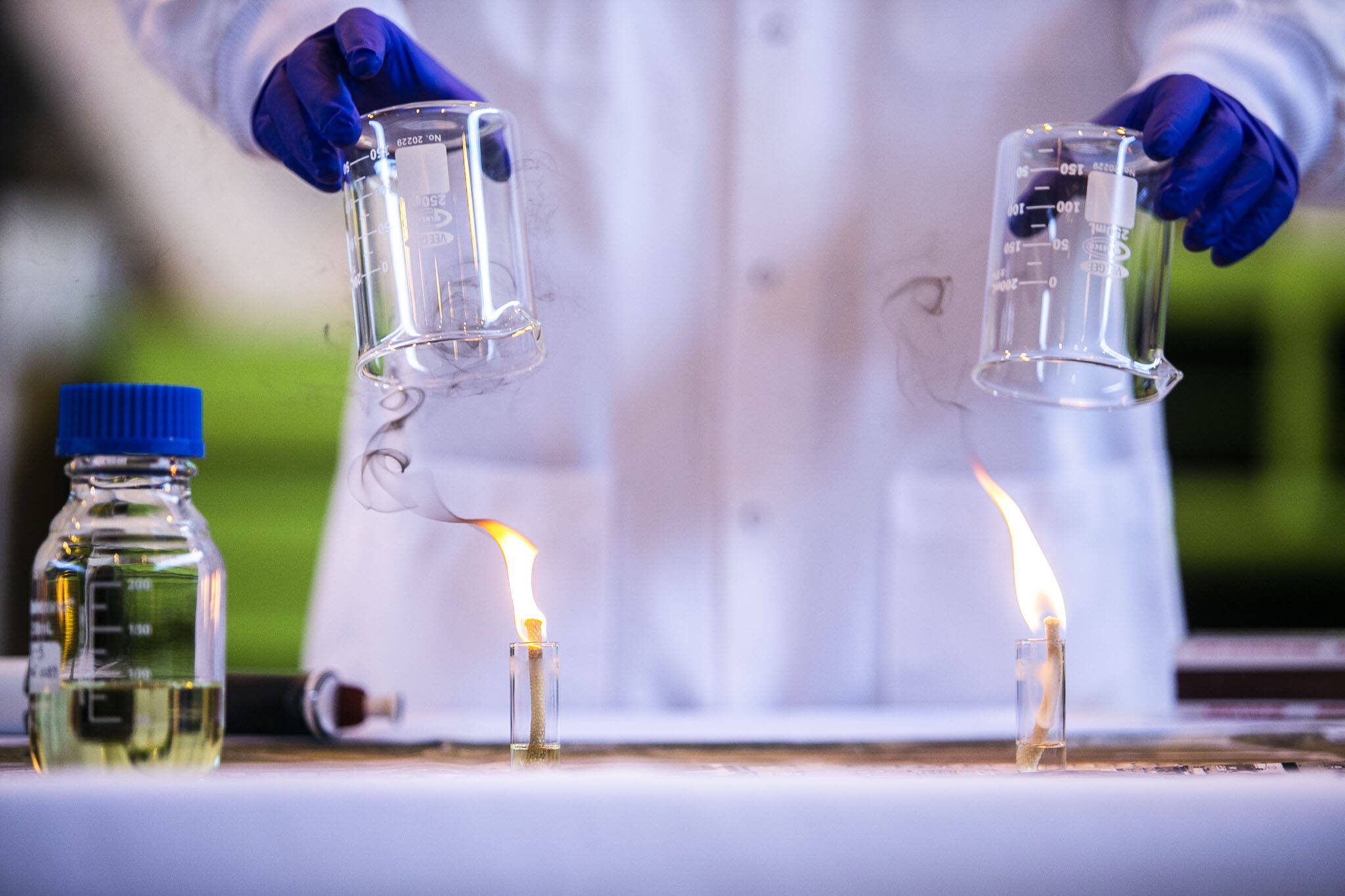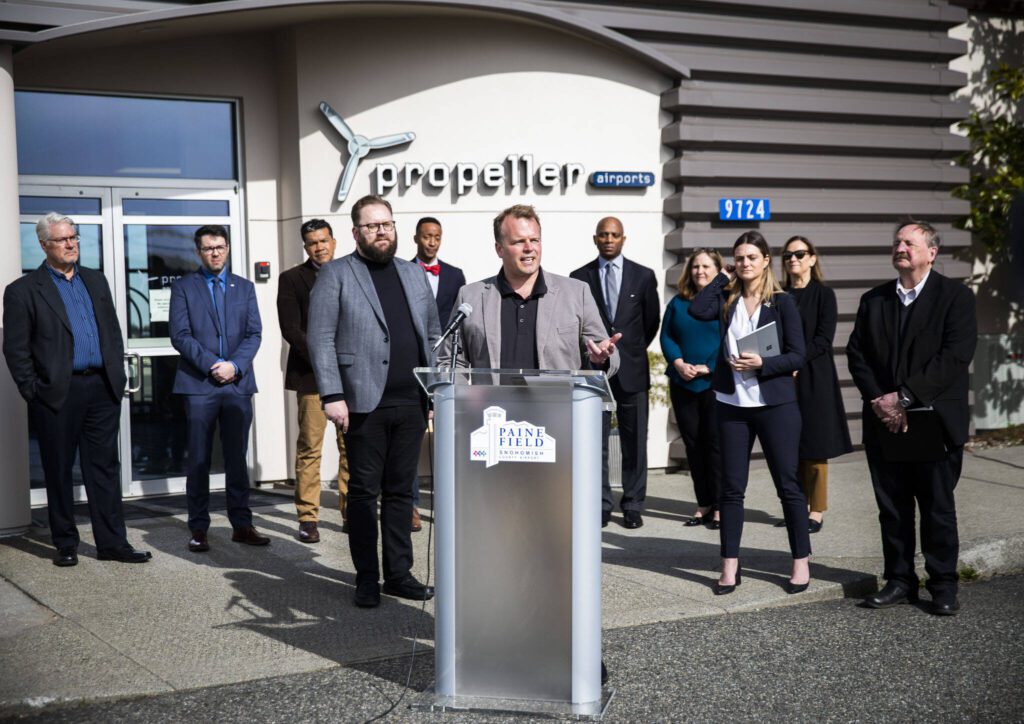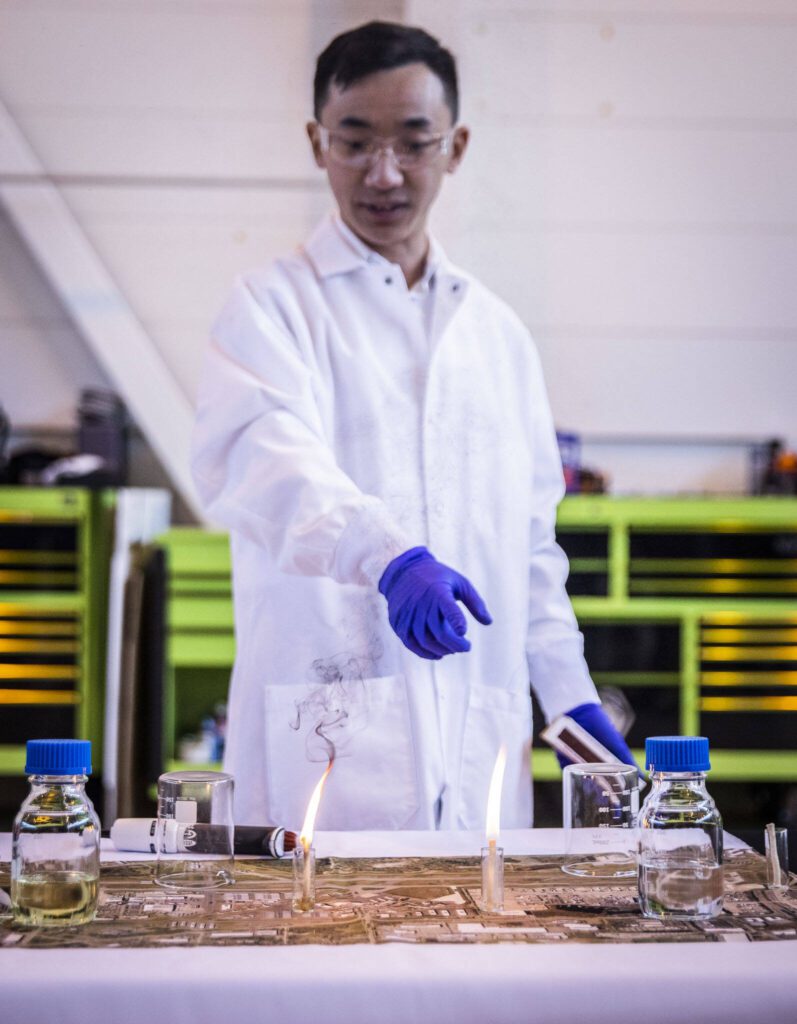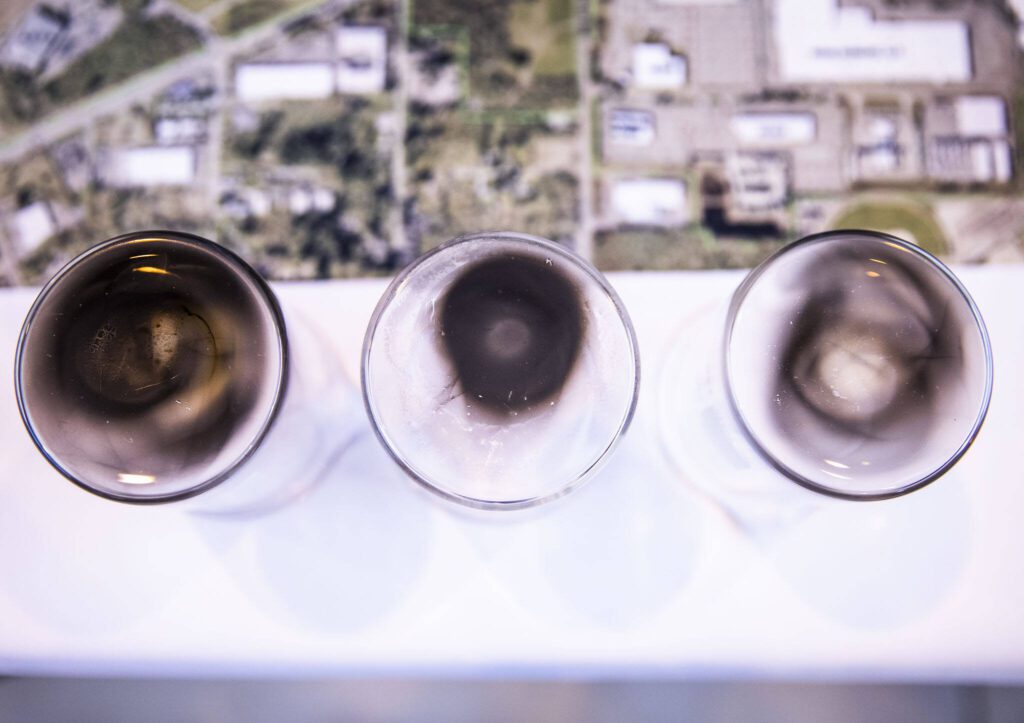EVERETT — It’s a cross between a seed bank and a test kitchen, except the main ingredient is jet fuel.
A new research and development center focused on sustainable aviation fuel will be established at Paine Field by 2027. The center will collect sustainable aviation fuel samples from around the world and then test them for safety, performance and chemical similarity to conventional jet fuel.
The facility, a joint venture between Snohomish County and Washington State University, will also be equipped to help manufacturers scale up SAF for commercial-scale production.
Officials announced plans for the new research center on Tuesday outside the offices of Propeller Airports at Paine Field.
“This is a first-of-its-kind research and development center for SAF,” County Executive Dave Somers told a small crowd of airport officials and reporters. “A repository of this type does not currently exist. … Washington State University will lead the way.”
To jump-start the project, the center is expected to receive $6.5 million in startup funds from the state Department of Transportation.
Sen. Marko Liias, D-Everett, chair of the Senate Transportation Committee, said he included $6.5 million to fund the center in the proposed transportation budget he’ll release Wednesday. Liias joined county officials at the airport this week.
Rep. Brandy Donaghy, D-Mill Creek, is sponsoring the provision in the House.
Officials envision the center as an eventual public-private partnership with funding derived from state and federal sources and private aerospace industry contributors.
Although a location for the facility at Paine Field has not yet been determined, several existing and greenfield locations at the Snohomish County-owned airport are under consideration, county officials said.
Officials hope to complete a business plan for the center this fall.
The low-carbon biofuels are typically produced from agricultural residue, including waste fats and oils, said Joshua Heyne, director of Washington State University’s Bioproducts, Sciences, and Engineering Lab in Richland, Washington.
Heyne is slated to lead the SAF center at Paine Field.
To demonstrate SAF’s “cleaner” than conventional jet fuel properties, WSU graduate student Harrison Yang performed a simple experiment Tuesday inside a hangar at Propeller Airports. Take a kitchen match to two samples of biofuel and conventional jet fuel and let them burn under a glass jar. Then examine the residue. SAF fuel produces a light gray film inside the jar while the jet fuel turns it black. (Don’t try this at home.)
The global aviation industry is currently responsible for generating about 2% of carbon emissions, as well as 12% of all transportation emissions, according to the Environmental Protection Agency.
Sustainable aviation fuel can reduce carbon dioxide emissions — a greenhouse gas — by as much as 80% per gallon, experts say.
In 2019, the global airline industry consumed 95 billion gallons of conventional aviation fuel.
Last year, just 18 million gallons of sustainable aviation fuel was produced.
So far, a limited supply of SAF and its higher cost are barriers to its more widespread use.
The Biden administration is targeting production of 3 billion gallons of SAF each year by 2030 and 35 billion gallons per year by 2050 — enough to meet the nation’s projected fuel demand for domestic flights.
Sheila Remes, vice president of environmental sustainability for Boeing, has said sustainable fuels are the “best short-term solution” to reduce the aviation industry’s carbon emissions.
One billion tons of biomass is enough to produce 50 to 60 billon tons of low-carbon biofuel, according to U.S. Department of Energy estimates.
“They can be dropped into the existing ecosystem — the airport, the fuel farm or the airplanes,” Remes told The Daily Herald in 2022.
Sustainable aviation fuel can be blended up to 50% with traditional jet fuel without having to modify existing airplanes, engines or fuel pipelines, she explained.
Last year, The Boeing Co. bought 2 million gallons of sustainable aviation fuel and delivered it to the fuel farms it maintains at the Paine Field, Renton and South Carolina airplane assembly plants.
At that point, it was the largest SAF fuel purchase by a commercial aircraft manufacturer, Boeing said.
The fuel, a blend of 30% sustainable fuel and 70% conventional fuel, is used to power some test flights, production flights and airplane delivery flights at the Everett assembly plant and other locations, the company said.
The county is home to “cutting-edge commercial aerospace manufacturing, which has been an important economic driver of the county for over 50 years,” Somers said. “With our history and resources, Snohomish County is the ideal place for businesses to invest in trailblazing climate change solutions.”
The county has become a hotbed of activity for companies focused on alternative power sources for aircraft.
In Arlington, Eviation Aircraft designed, built and test-flew a fully electric commuter plane. The airplane, dubbed Alice, spent 8 minutes in the air last year. The plane’s electric motors were developed and built by magniX, which moved its headquarters to Everett in 2021.
magniX also created the propulsion system for Universal Hydrogen. The California-based company replaced one two conventional turboprop engines on a De Havilland Dash 8 with a magni650 electric motor. On March 2, the hydrogen fuel-cell powered aircraft made a successful 15-minute test flight above Grant County International Airport in Moses Lake.
With that flight, the company’s retrofit of a 40-seat Dash 8 airplane became the world’s largest aircraft powered by hydrogen fuel cells to fly principally on hydrogen power.
Janice Podsada: 425-339-3097; jpodsada@heraldnet.com;
Talk to us
> Give us your news tips.
> Send us a letter to the editor.
> More Herald contact information.




























